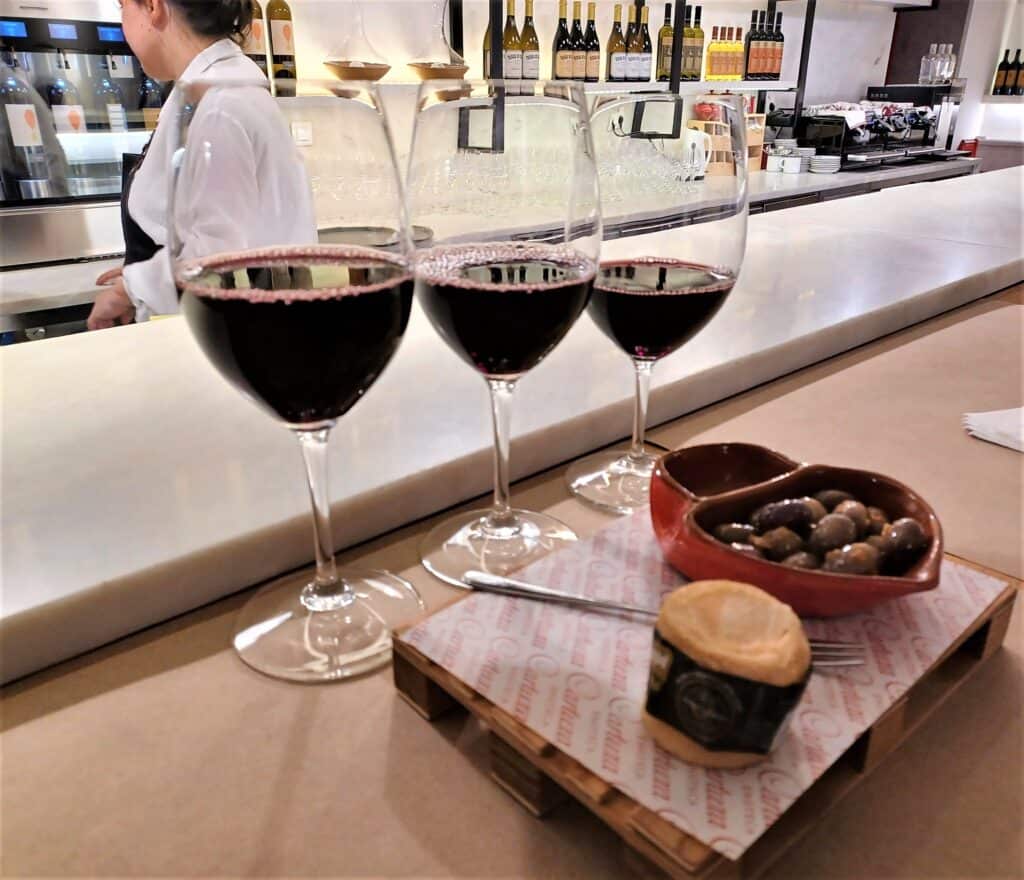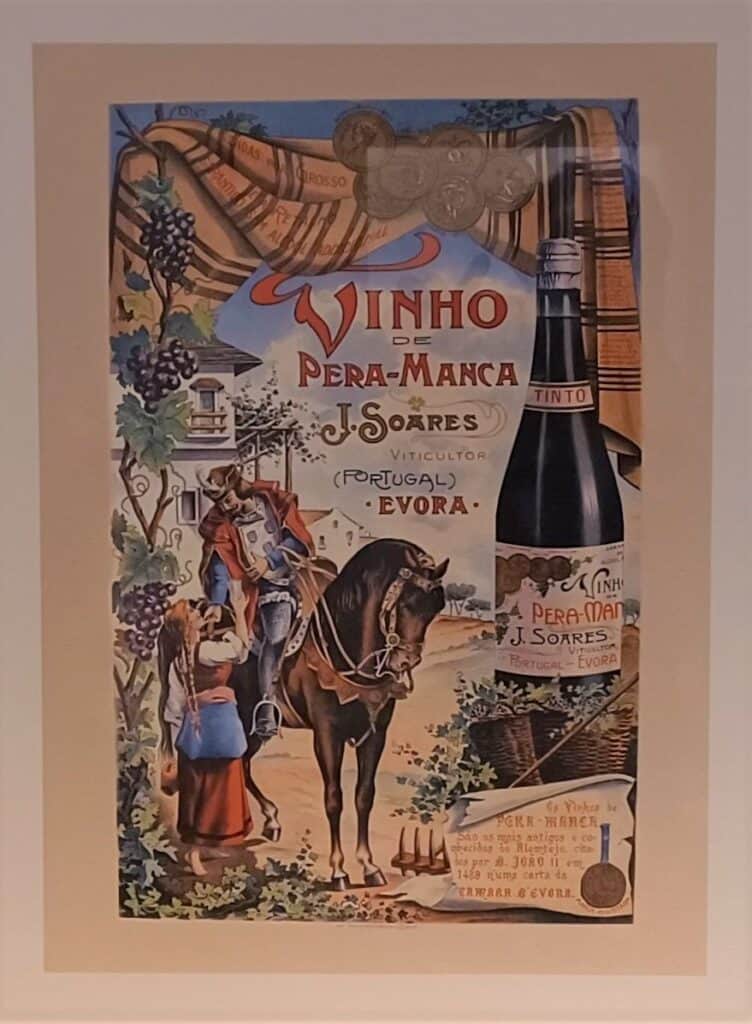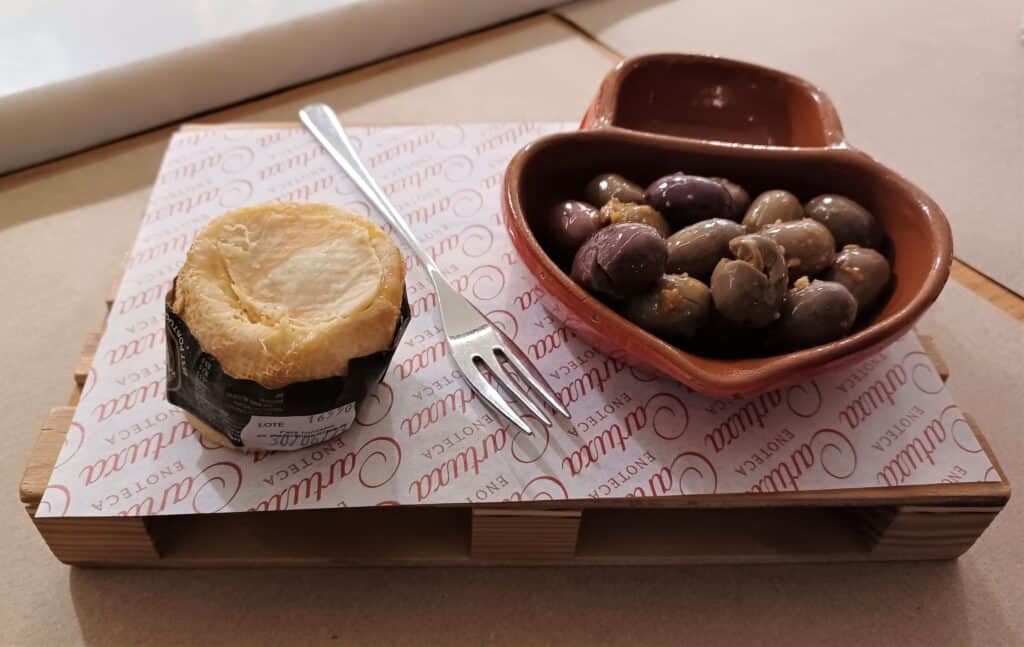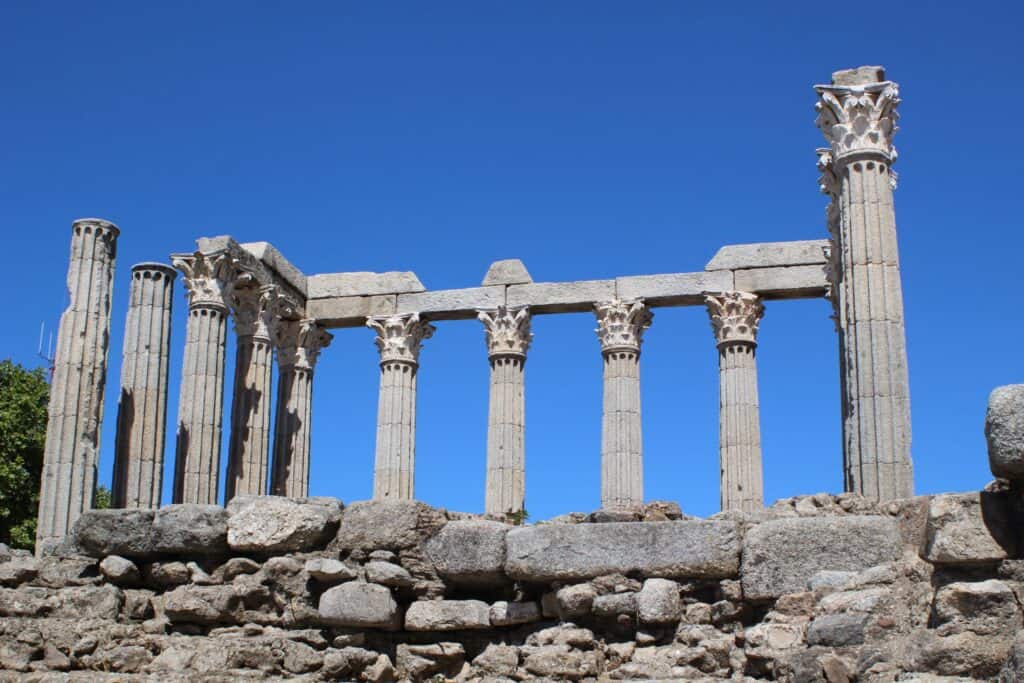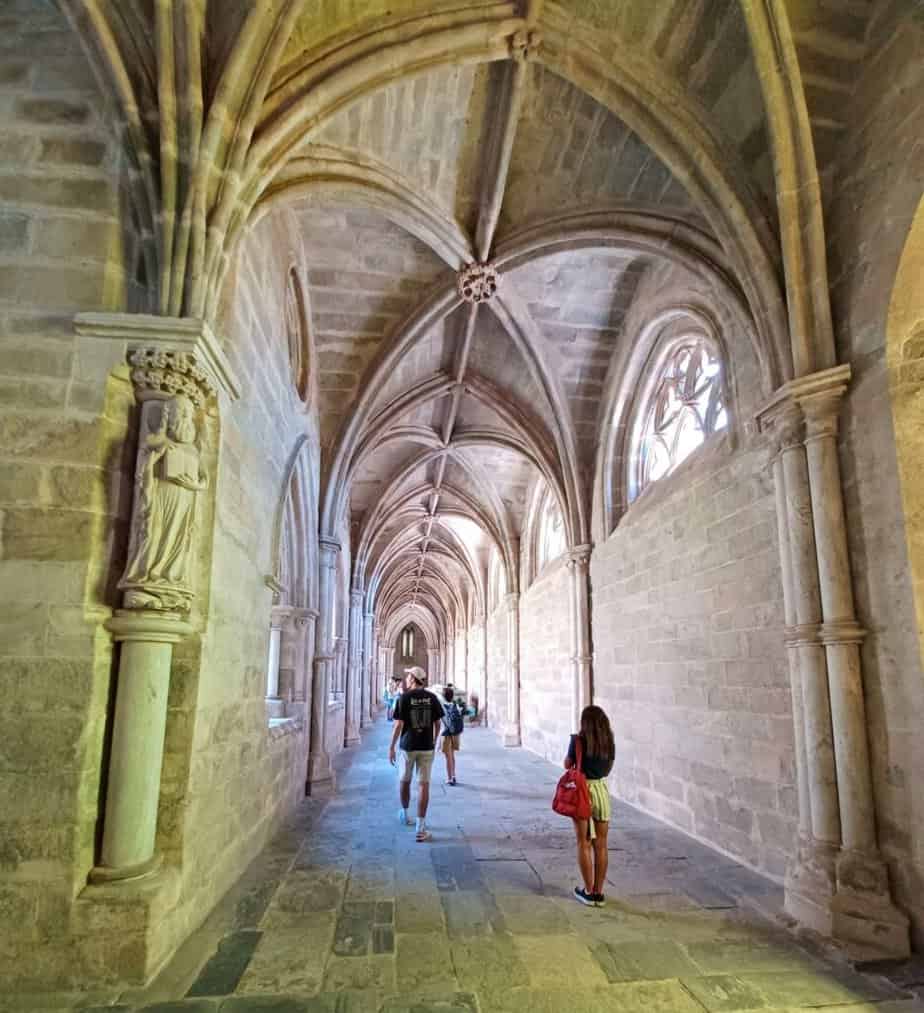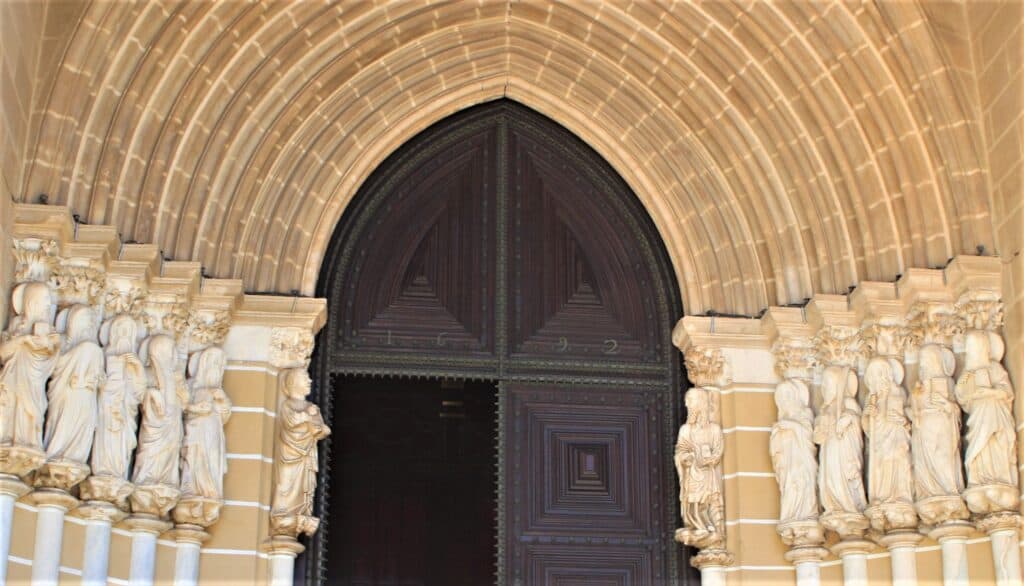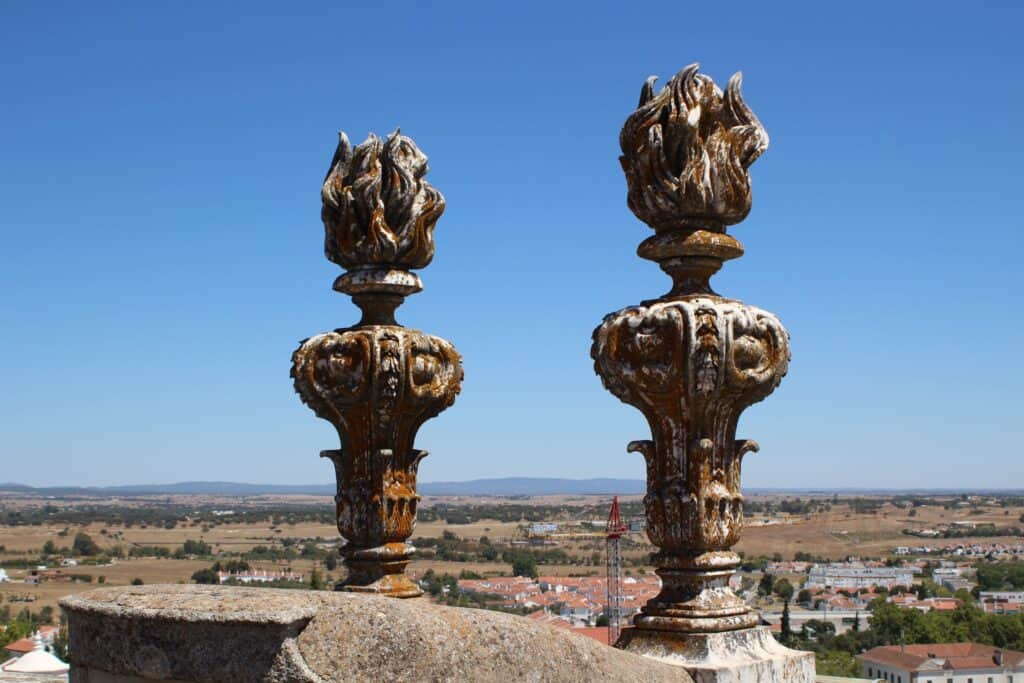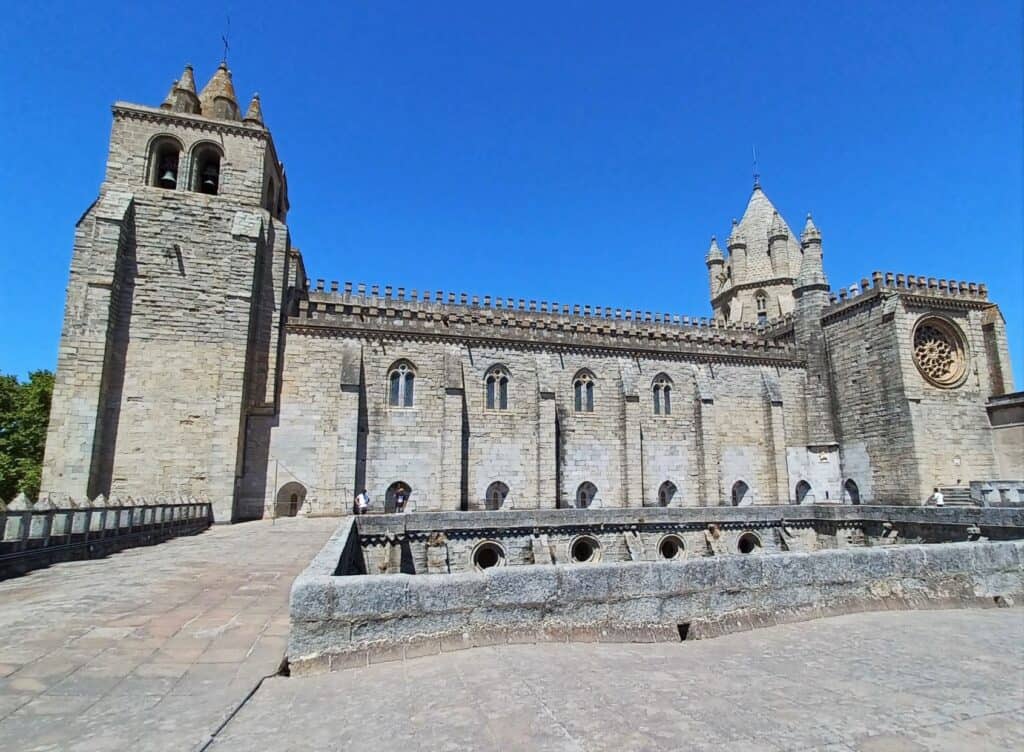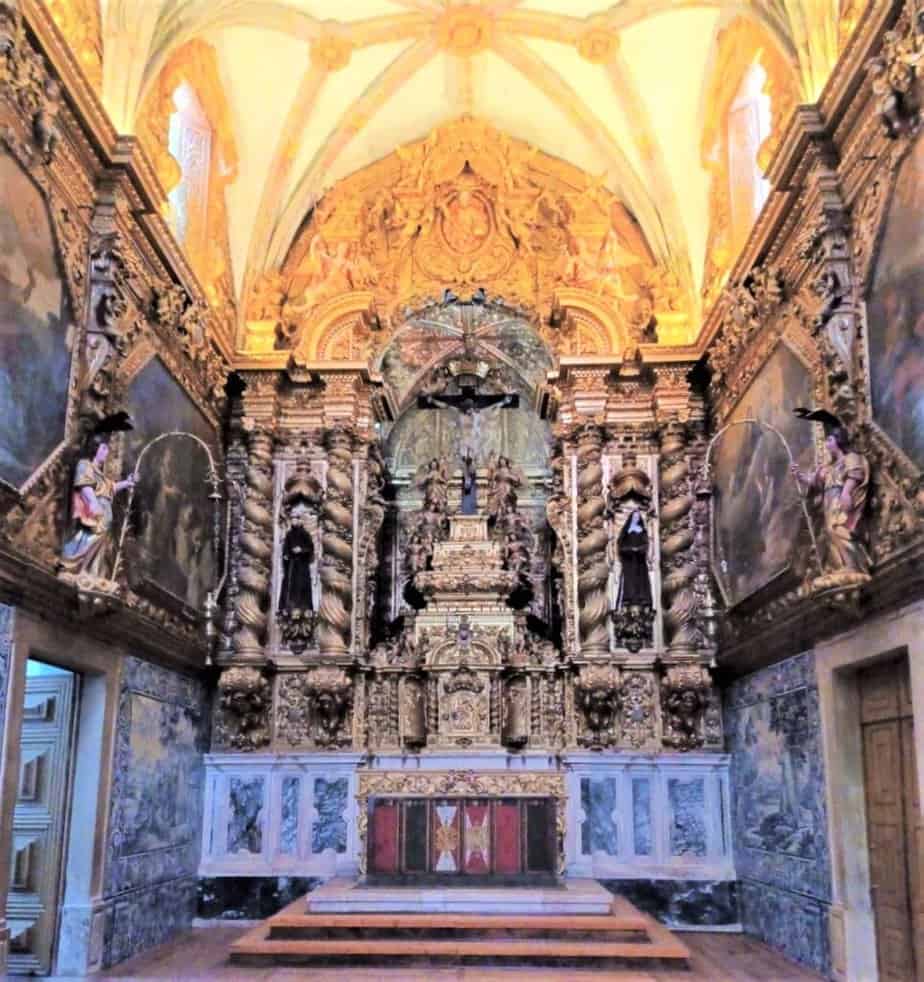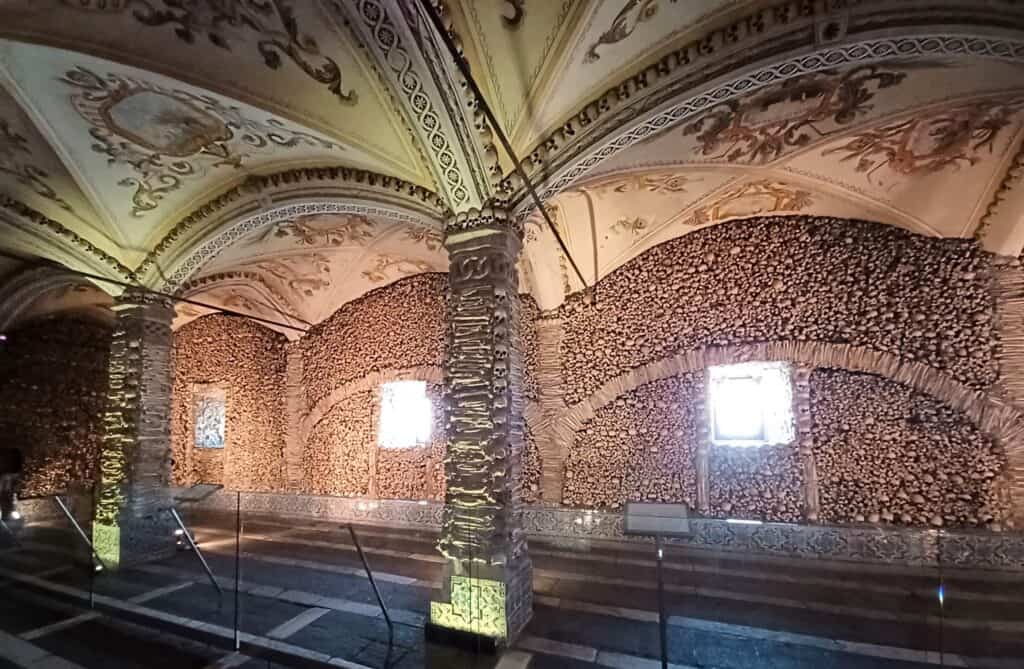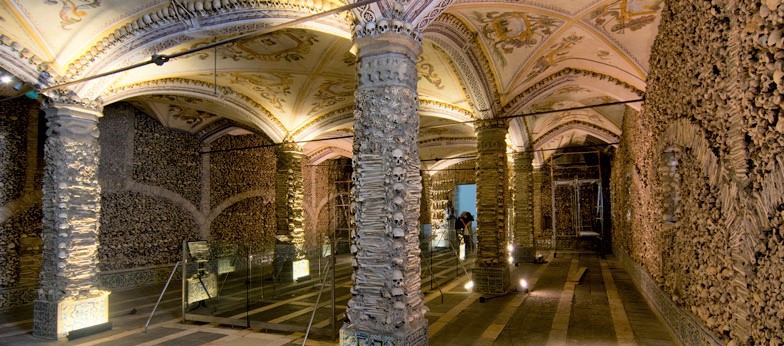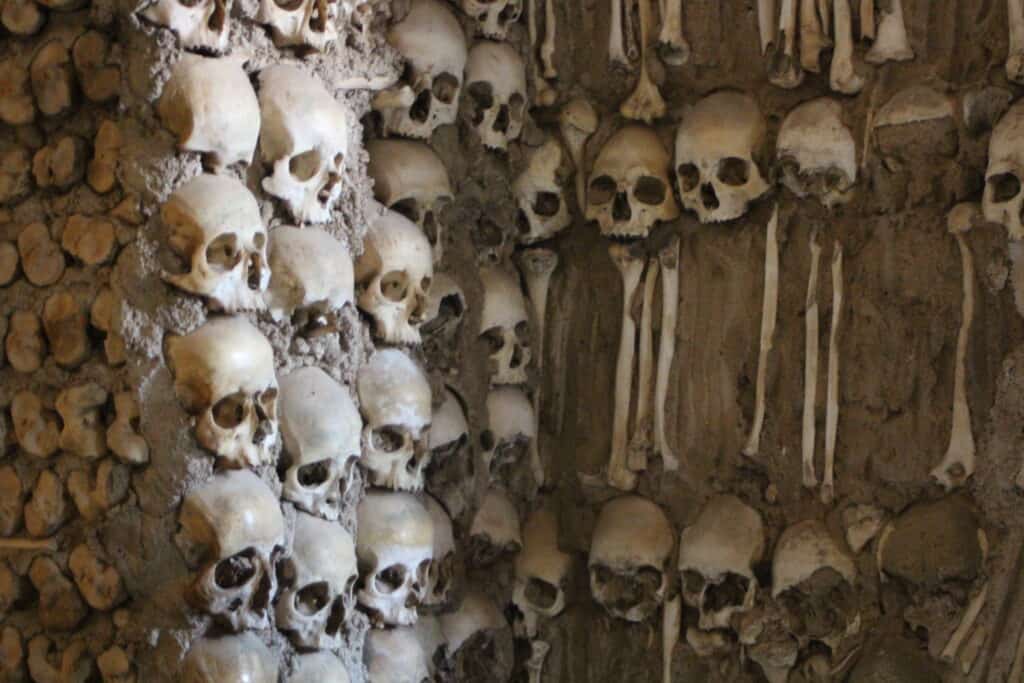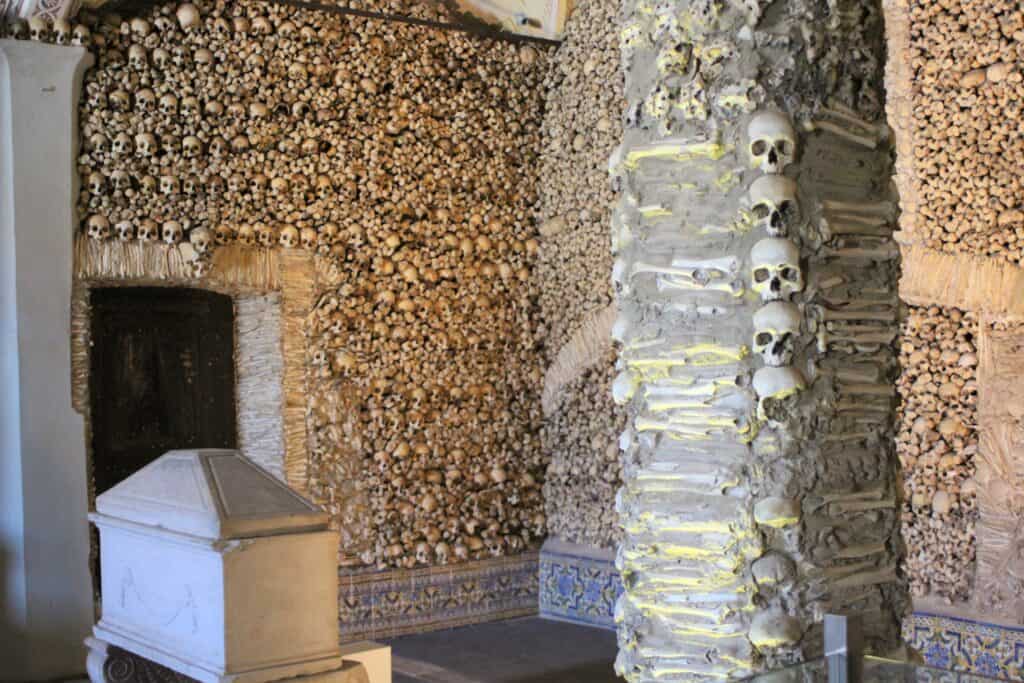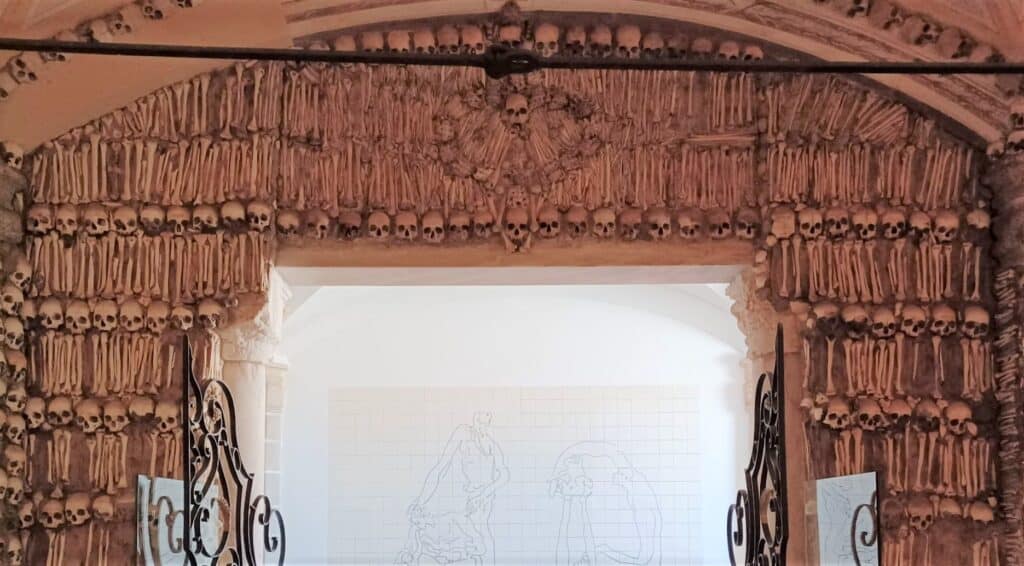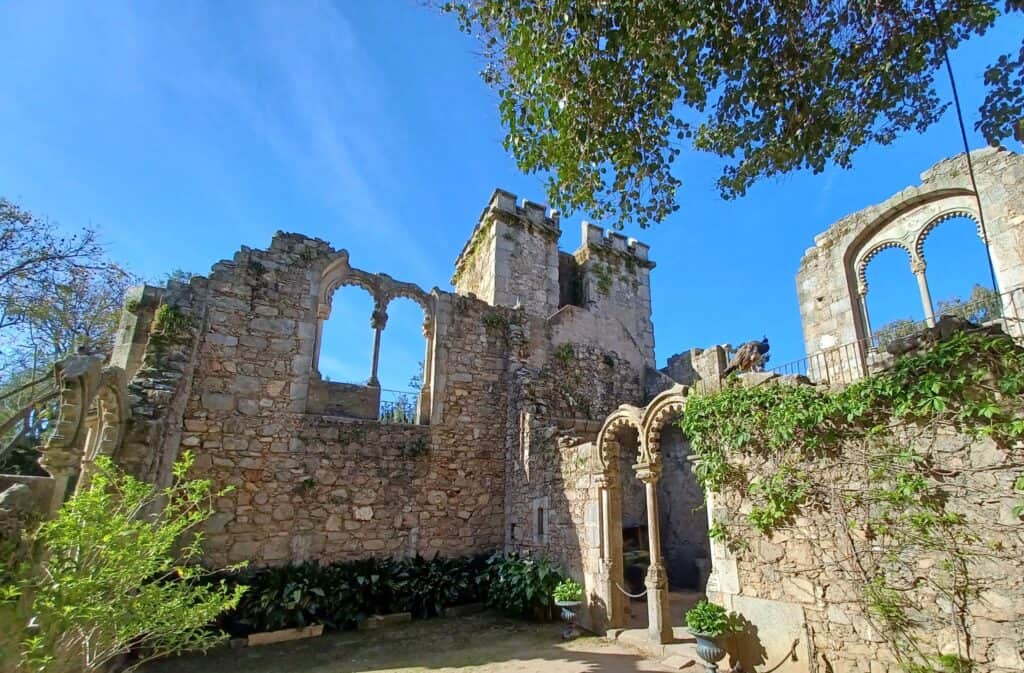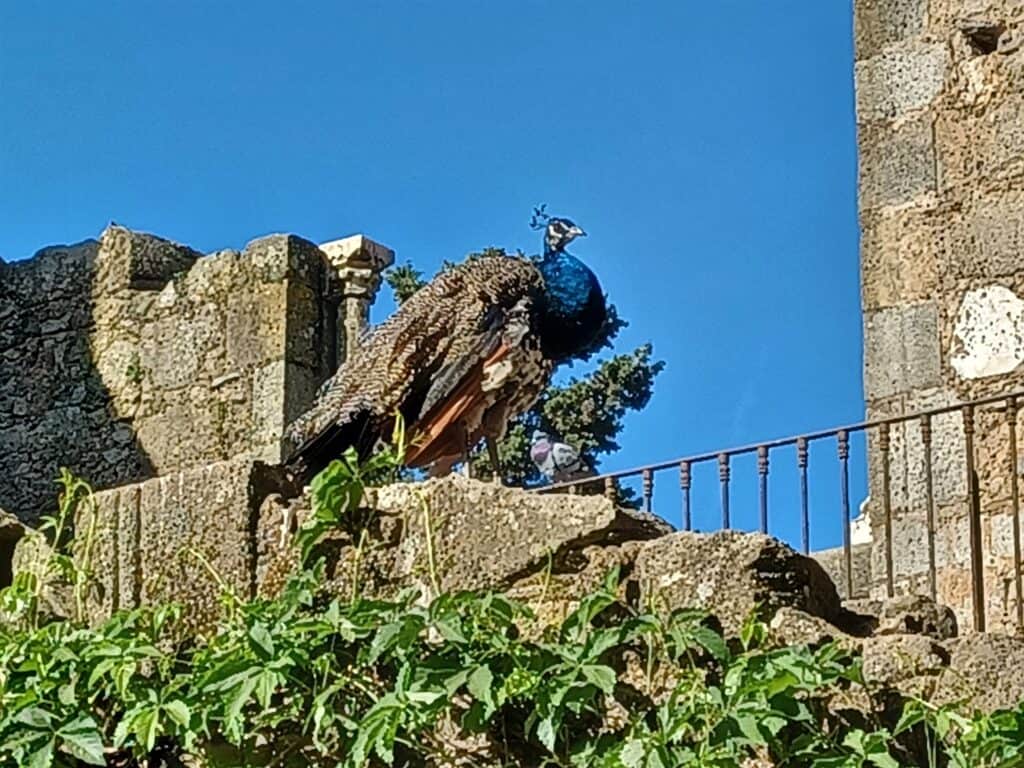A Portuguese town heavy on tourist attractions has a surprisingly vibrant food scene.
A Short History
Neanderthals moved into the Iberian Peninsula (present day Spain and Portugal) 200,000 years ago. The area around present-day Évora has been inhabited for at least 5,000 years and likely for several millennia before that.
The Celti (Célticos) occupied the land for a few hundred years before the Romans arrived in 57 BCE. The Romans built up the city (including the city wall which is still partially standing and the temple) and it became important because it was on the trade route with Gaul (present-day France) and Lusitania on the Iberian Peninsula. Évora was also prized because its soil and climate were ideal for wheat production.

Évora fell into decline and was taken over by the Visigoths in 584 CE. Later, the Moors conquered the city in 715 CE and ruled for 450 years until the reconquest by Gerald the Fearless (Geraldo Sem Pavor) in 1165.
Portuguese royalty favored Évora and the city thrived as palaces and cathedrals were built and the arts were patronized. Évora was also home to a large African slave population.
By the 14th century there was a large Jewish population in Évora, but they were force to live in their own neighborhood and their rights were severely curtailed. At one point there were two Synagogues in the Jewish Quarter of Évora. In 1536, and continuing for almost 250 years, the General Council of the Holy Office of the Inquisition in Portugal established a court in Évora where those accused of being Jewish (or Muslim or any number of other “offenses”) were tried and barbaric punishments were handed out. Almost 10,000 people were tried in Évora with sentences ranging from confiscation of property to banishment to whipping or sabenito (the wearing of a red garment and large hat indicating the infraction), to the execution of nearly 400 souls were carried out. Archaeologists have discovered that their bodies were often unceremoniously dumped outside the courthouse. Today, the Inquisition Court is a center for the arts.
When monasteries of Portugal were closed and the Jesuits, who had been a force for education in Évora, were expelled, the university in Évora closed in 1759 and the city again fell into decline. The university reopened in 1973 and today Évora boasts a lively student population.
Foodie Évora
For a city with a population of about 50,000, Évora punches far above it’s weight class when it comes to food culture. There are a couple Michelin recognized restaurants, numerous fantastic places that offer traditional Portuguese cuisine, and local pastries that go far beyond the usual riffs on Pastel de Nata.
Most of these pastries fall into the category of convent sweets, little tarts and cakes that were invented in the local Convento de Santa Helena do Monte Calvário (Convent of St. Helena of the Mount Calvary) and Convento de Santa Clara. Both of these convents are still standing, although the main part of the Convento de Santa Helena is now offices for the diocese (a couple other buildings have been converted to hotels) and the Convento de Santa Clara is occasionally open for art exhibitions.
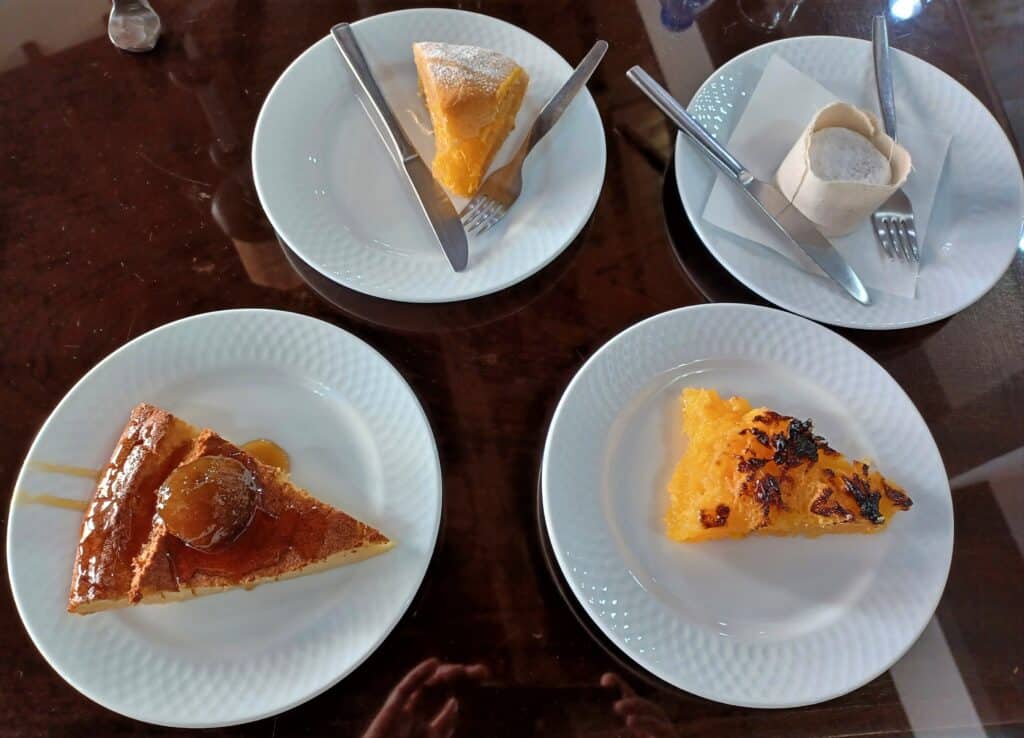
Pastelaria Conventual Pão de Rala has a great selection of convent sweets, all extremely tasty and well made. Pastelaria Violeta is another excellent choice for a convent sweet.
Queijada de Évora
Little tarts made with an egg yolk and sheep milk cheese custard, Queijada de Évora might sound strange, but it is quite delicious. The sheep milk cheese is rather mild, not salty and overpowering like an aged pecorino. Instead, the rich egg yolks offset the cheese nicely, although you do get a little hint of the sheep’s milk. Pastelaria Violeta makes an amazing version.

Queijinho de Ceu
One of my favorite tarts in Évora, Queijinho de Ceu is a sweet almond dough surrounding a soft and creamy egg custard. When I first heard about the Queijinho de Ceu, it was described as marzipan surrounding the egg custard. That didn’t sound too appetizing, but I gave it a go anyway. Turns out the almond dough is more cake-like and not nearly as sweet as marzipan. It’s a can’t miss when visiting Évora.
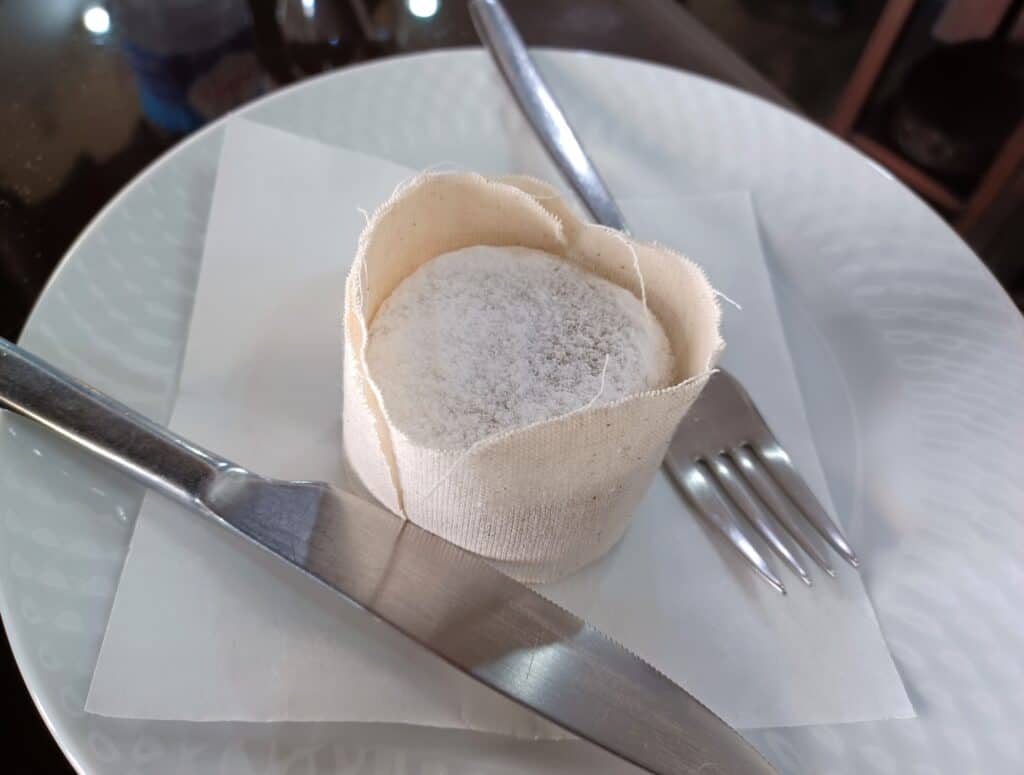
Pão de Rala
The Pão de Rala is another treat that’s made with an almond dough. This time, the filling is sweet squash jam. Don’t be put off by squash in your cake, after all, pumpkin pie is made with squash and Pão de Rala is way better, IMHO. Some versions add lemon or orange zest.
When you name your bakery after a specific dish, your version better be good. Luckily, Pastelaria Conventual Pão de Rala delivers.
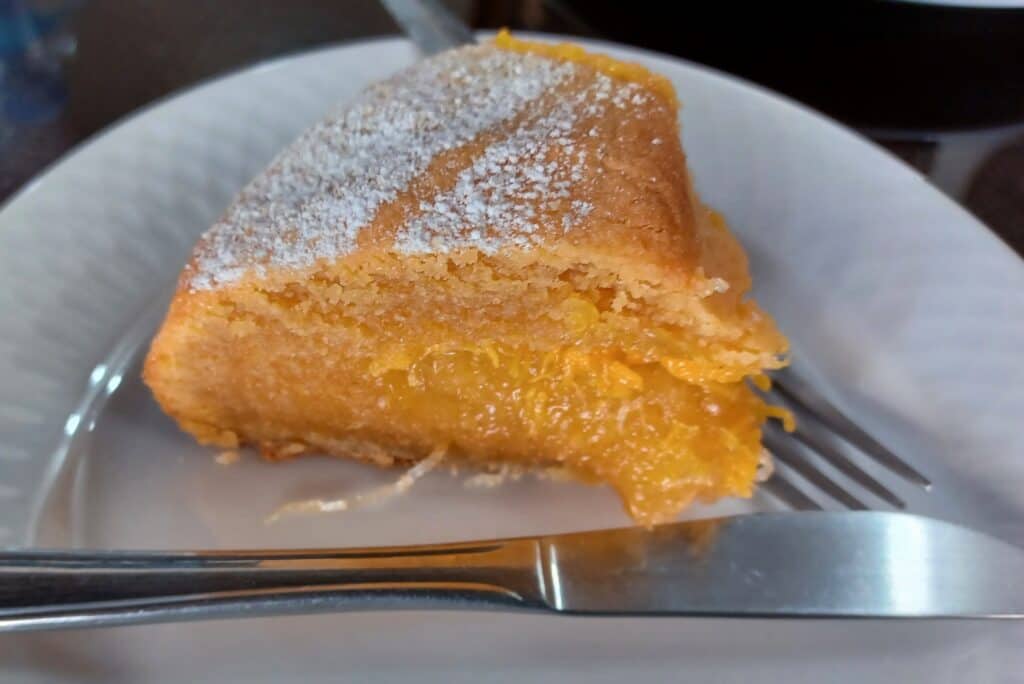
Serica
Sometimes spelled Cerica, Serica is an egg pudding with a soufflé-like texture. The pudding isn’t very sweet, but never fear, a syrup is often poured over the Serica and it’s then topped with a sweet poached plum. Pastelaria Conventual Pão de Rala’s Cerica (they spell it with a “C”) is the best I’ve ever had.
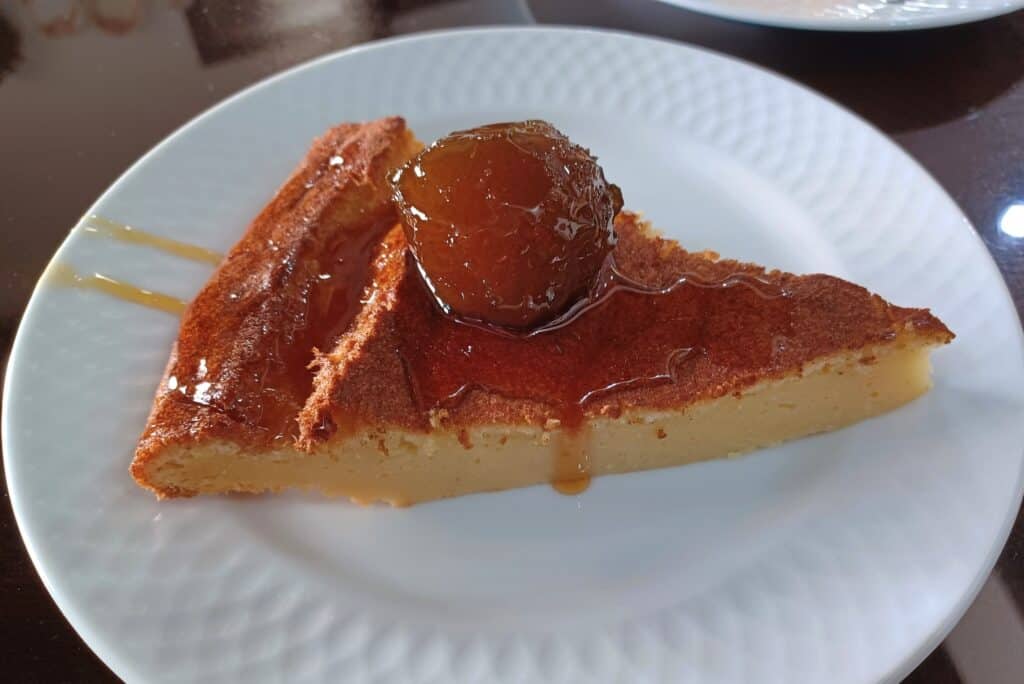
Encharcada
Encharcada is one of the more unusual treats on this list. To make it, you heat water and sugar to form a simple syrup. A cinnamon stick or lemon peel may be added to infuse additional flavor. Then, egg yolks are pressed through a sieve into the simple syrup, forming strands of cooked eggs. This mixture then placed in a pie plate and a culinary blowtorch is used to caramelize the top of the Encharcada.
The taste is quite sweet and eggy, though the cinnamon or citrus can balance that a bit. If you’re the kind of person who puts maple syrup on their scrambled eggs, you’ll love Encharcada.
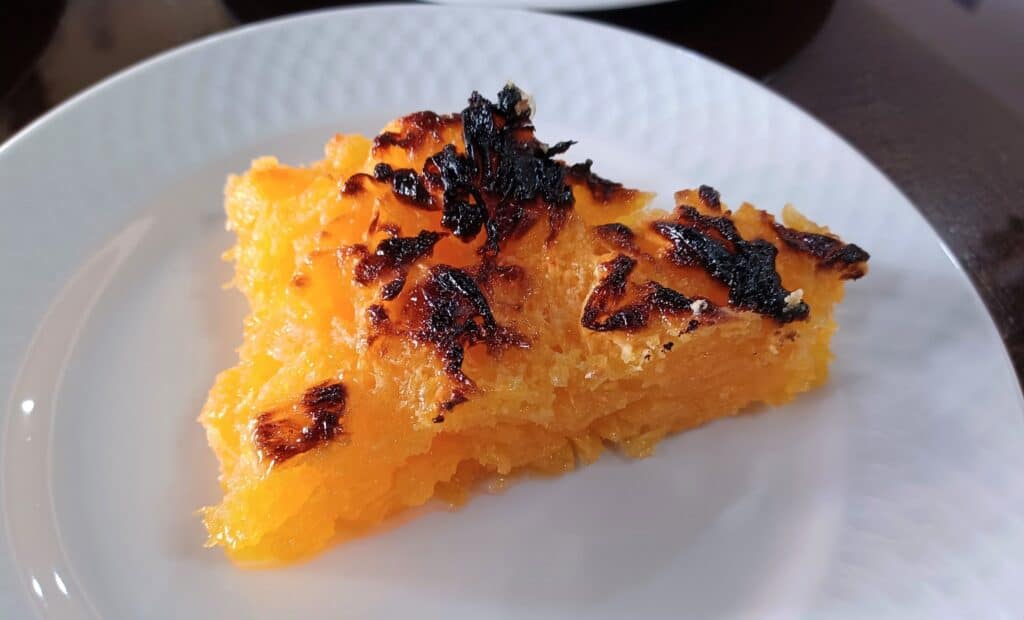
Queijo de Évora
Évora has a long tradition of cheesemaking that dates back centuries. There’s a even a local legend that back in the day, peasants’ wages were paid in the form of cheese.
The DPO (Protected Origin Designation) cheese from Évora is a raw sheep’s milk cheese. Rather than animal rennet, Queijo de Évora uses a thistle as a coagulate, similar to the cheese made in the Azeitão, not far away. Aging brings out even stronger flavors in Queijo de Évora.
Queijo de Évora is available at practically any restaurant in town. You can also shop at the tiny Mercado Municipal 1º de Maio. There are a couple cheese vendors there, though the market itself is often quite sleepy. Or go to Zé do Bacalhau where they also have a nice selection of Queijo de Évora.
Pão Alentejano
In Alentejo, bread is traditionally made with wheat flour. The crumb is rather dense and the crust is thick and crunchy. Pão Alentejano is distinctive for the bump or head on top of the loaf. Any bakery or restaurant in Évora will serve Pão Alentejano. The bread is also an important ingredient in several other dishes like Açorda.

Açorda
Açorda is a soup that makes use of leftover Pão Alentejano, the thick crusty bread from the region.
A paste of garlic and cilantro (sometimes other ingredients like peppers) is spooned into a soup bowl. Then, eggs are poached in boiling water. Once cooked, the eggs are removed and the boiling water is added to the garlic/cilantro paste. Stale Pão Alentejano is added and allowed to soak up the garlicky broth. Finally, the Açorda is topped with the poached eggs and served.
Traditionally, Açorda was called “beggar’s soup” because it was made of leftover Pão Alentejano and no meat. However, in recent times, a chicken or beef stock is sometimes used instead of water so vegetarians should make sure the Açorda being served doesn’t have any meat in it.
Sopa de Tomate Alentejana
Portugal spent a lot of time fighting wars with their neighbor Spain. In 1665, the Portuguese, with some help from their friends the British, won the Battle of Montes Claros and captured many Spanish soldiers. These prisoners were held in Alentejo and fed a dish from the region, Sopa de Tomate. Legend has it that when the prisoners were freed they returned home and tried to replicate the dish. This eventually became Salmorejo, a dish closely associated with Cordoba, Spain.
The original Portuguese soup, Sopa de Tomate Alentejana, is made with a base of tomatoes, garlic, and onions. While there’s nothing unique about that, what’s added next makes the soup special. An egg is gently slid into the soup where it is poached in the tomato broth.
Sopa de Tomate Alentejana is served by ladling the soup over some Pão Alentejano. Normally, it is topped with Chouriço. Vegetarians can request the Chouriço be omitted, however, be aware that sometimes the base of the soup is made with the rendered fat of the Chouriço. Ask before ordering. Also, vegans can be accommodated by requesting the egg be omitted.
Variations on Sopa de Tomate Alentejana include adding potato or green pepper. Sometimes the soup is served with grilled figs on the side to cut through the acidity of the tomatoes.
Sopa de Tomate Alentejana is such a classic dish that many restaurants have it on the menu including A Bruxa D’Évora and Café Alentejo.
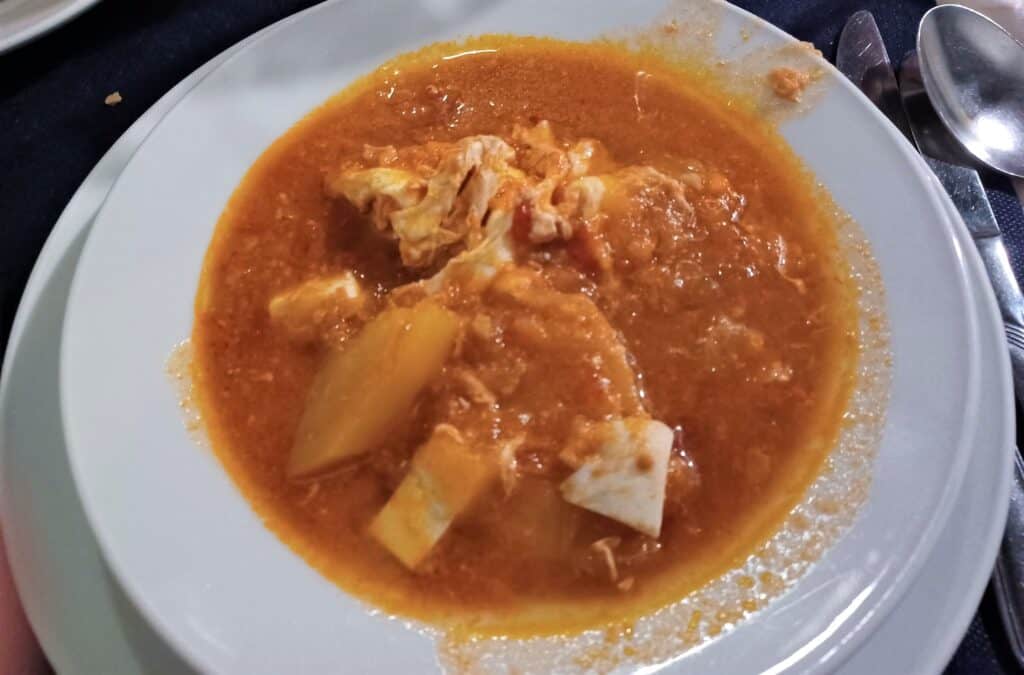
Asparagus and Eggs
Portuguese people love eggs! It seems everything comes with a fried egg on top. From sandwiches to French Fries, don’t be surprised if you see an egg topping your dish, even if you didn’t order it.
In spring, when asparagus is in season, menus feature “Ovos Mexidos com Espargos Selvagens” or Scrambled Eggs with Wild Asparagus. Often, this dish also has Chouriço as well. Vegetarians can request it “sem Chouriço.”
My all-time favorite place to get Ovos Mexidos com Espargos Selvagens in Évora, in all of Portugal really, is Botequim da Mouraria. The tiny restaurant has no tables, just a bar with eight seats and a two seat high top. They’re only open Monday through Friday for a couple hours at lunch. That’s it. No dinner, no weekends. But, it is so worth stopping by.
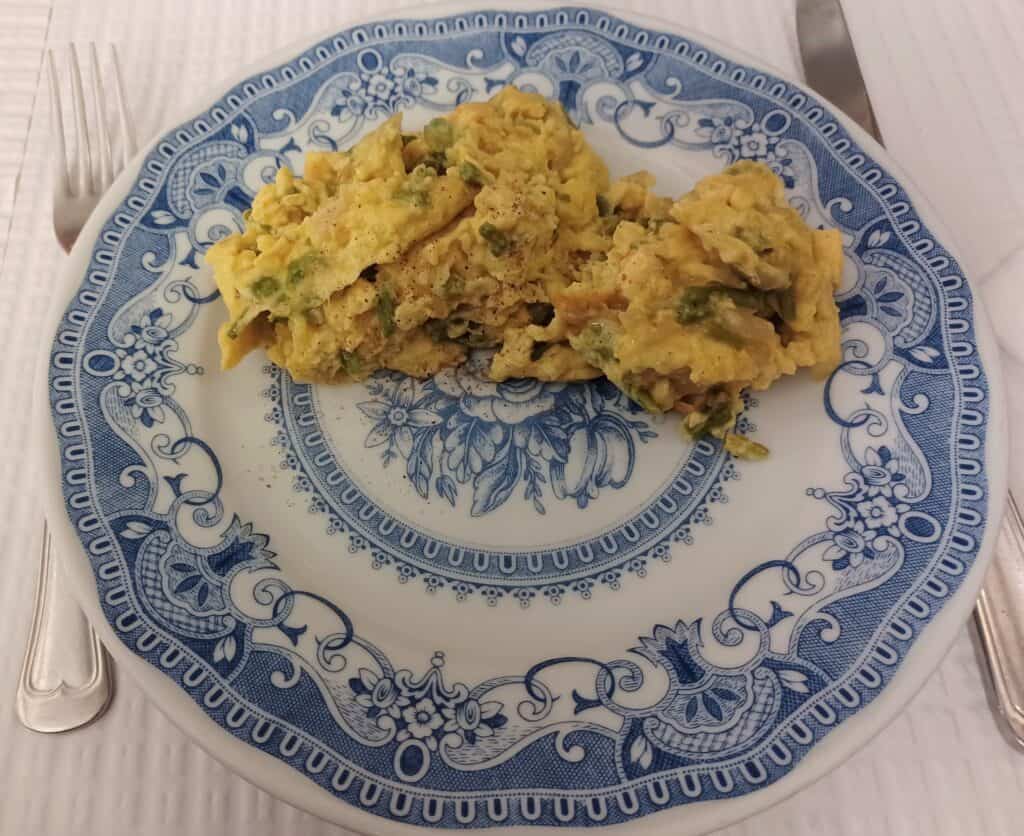
Domingos and his wife run the place. She is the brilliant chef and he is the jovial front of the house host.
The menu is full of traditional Portuguese dishes prepared simply. What makes them so delicious is the chef’s skill and the super-fresh ingredients she uses. Roasted mushrooms are made with just olive oil and salt. Yet, they are scrumptious.
Then, there’s the Asparagus and Eggs. Domingos brings out a huge platter and, using a set of tongs, fills your plate with fluffy goodness. So good!
There is an extensive wine list from Alentejo and all over Portugal to pair with your meal. The small space and bar seating area lends itself to a feeling of community amongst diners. After the meal, Domingos brings out a camera and takes our pictures, saying he will put them on the digital picture frame that boasts rotating images of happy customers. Highly recommended!
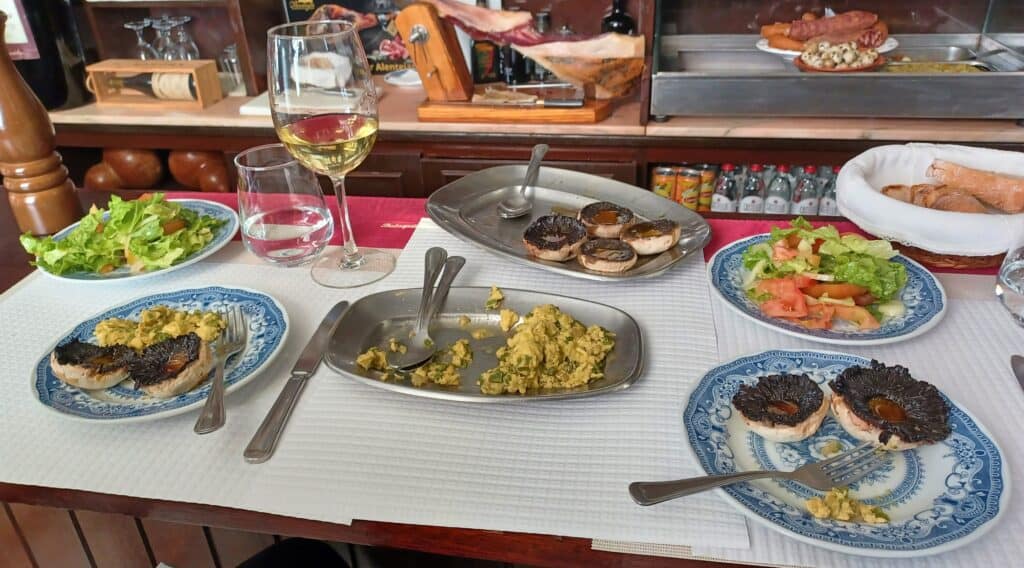
Drinking in Évora
Alentejo (Évora is its seat) may not be Portugal’s best-known wine-making region, but it produces the most wine in the country. Wine-making in this region may date back 10,000 years or more and viniculture was well established when the Romans arrived 2,000 years ago.
There are eight PDO (Protected Designation of Origin) regions in Alentejo including Évora.
Many native varietals like Antão Vaz are grown in Alentejo along with international grapes like Cabernet and Chardonnay. One of the most popular grapes for blending is Aragonez, the Portuguese name for Tempranillo. Aragonez ripens early in the season and the grape is relatively low in acidity making it ideal for blending and aging in oak.
In the past, wines from Alentejo were mass produced, low quality, and sold in bulk. However, after the fascist regime was deposed in 1974, better wine-making methods were introduced, and today, Alentejo produces some top flight wines.
Any restaurant or cafe will undoubtedly have regional wine available by the glass. But, there are a couple nice spots where you can taste the best that Alentejo has to offer.
Cartuxa
Originally a Jesuit retreat in the late 1500’s, the first vines were planted on the property in the early 1900’s. While the tradition for many wineries was to pass the business down to succeeding generations, Cartuxa’s founder, Vasco Maria Eugénio de Almeida, had strong community ties and a foundation was created to run the winery and carry out local philanthropic missions.
You can visit the winery (about 2km from Évora) or stop by the tasting room which is just a few steps from the cathedral. The modernist space has a dozen wines by the glass, all from the winery.
The quality of the offerings is all top-notch with the Cartuxa reserve being especially impressive. Ask questions and maybe get a recommendation from your server. Everyone I’ve talked to who works there is a wealth of knowledge. Pair your tastings with some Queijo de Évora, a raw sheep’s milk cheese. A definite must-stop for wine lovers or anyone looking for a break from sightseeing.
Adega Ervideira
The 4th and 5th generations of the Ervideira family are running the Ervideira winery, just outside Monsaraz, Portugal. They’ve opened a nice wine shop in Évora where you can sample different vintages from the winery or buy a bottle or two. The winery is also open for visits; it’s about a 30 minute drive.
Rota dos Vinhos
Here you’ll find a small information center with panels explaining the long history of wine-making in Alentejo. There are also tastings available we well as information about visiting location wineries.
Botequim da Mouraria
I mentioned Botequim da Mouraria earlier (see above), as one of my favorite places to eat in Évora, but it’s worth talking about here as well. The owner has his personal collection of wine on display in the restaurant. I spotted some bottles over 70 years old! They’re not for sale, but there is an extensive wine list from Alentejo and all over Portugal from which you can order a glass or a bottle.

Things to do in Évora
A word to the wise. Bring a good pair of walking shoes. I know you hear that all the time in Portugal, but it’s especially true in Évora. The streets are very uneven and sometimes there’s no sidewalk. So, wear some sturdy shoes and your feet will thank you later.
Roman Temple of Évora (Templo romano de Évora)
One of the best preserved Roman temples on the Iberian Peninsula is in Évora.
The Roman Temple of Évora was built in the 1st century CE in honor of Caesar Augustus. The temple was partially destroyed by the invading Visigoths. By the 14th century, the temple was in shambles and used to house cattle. Then the temple was used as a butcher shop for almost 500 years until 1836.
Restoration of the temple finally began in the 1860s when Medieval additions were removed and the fantastic pillars and intact base of the temple were fully revealed. The marble and granite Roman Temple of Évora was given UNESCO World Heritage status in 1986.
Sometimes incorrectly called the Temple of Diana because of a story made up by priest in the 18th century, the structure has no association with the goddess of the hunt.
The Roman Temple of Évora is free to view, however, access to the temple itself is not allowed.
Cathedral of Évora (Catedral de Évora)
After Gerald the Fearless (Geraldo Sem Pavor) reconquered Évora from the Moors in 1165, the Christians celebrated by building a church dedicated the Mary (did these goes know how to party, or what?). The initial church was completed in 1204 and was pretty small.
Then, in 1280, the church underwent the first of its major expansions. The design was early Gothic. But, they weren’t done. Gothic cloisters were added and then Manueline (late Gothic) designs in the 16th century. The stunningly magnificent main chapel, a Baroque masterpiece, was completed in the 18th century.
Taken as a whole, the Cathedral of Évora is the largest Medieval cathedral in all of Europe.
Legend has it that the flags that flew from Vasco da Gama’s ships on his first voyage to India were blessed at the cathedral in 1497.
The imposing structure is visible from quite a distance, owing to the spectacular dome on the church and visiting is a must in Évora. There’s a small fee to see the main cathedral, which is jaw-droppingly gorgeous. The soaring dome ceiling held aloft with Italian marble columns is fantastic. Take some time to enjoy the artwork in the baptistry and naves.
For a couple extra Euros you can visit the cloisters and even climb on the roof of the cathedral. I highly recommend doing both. In the cloisters you’ll be met by more impressive Gothic arches. Climb the staircase to get a view of the courtyard.
Before heading to the roof, walk through the relatively small museum featuring some of the church’s treasures including some gold and silver work and several Portuguese Renaissance paintings.
Then, climb to the roof. Bell towers, decorative finials, and the best views in Évora await.
Évora Museum (Museu Évora)
Just a few steps from the cathedral is the Évora Museum. It contains over 20,000 objects including Roman statues, Medieval tombstones, and, since this is Portugal, beautiful azulejo tiles. But the centerpiece of the museum’s collection is panels depicting the life of Mary and the passion of the Christ. The panels were painted in the 14th century by students at the Bruges School in Belgium and commissioned by Bishop Afonso of Portugal. The names of the artists have been lost in time.
Imagine what these panels must have looked like in their original home at the cathedral.
St. Francis Church (Igreja de São Francisco)
Originally, a 13th century Romanesque church sat on this site. In 1475 a new church Gothic-style church was constructed on site. St. Francis Church was completed about 75 years later.
Inside is an imposing nave with soaring arches and twelve small chapels on the sides between the buttresses. The gold gilding and carved woodwork in the church are also quite good. But, the reason most people come here is the Chapel of Bones.
Chapel of Bones (Capela dos Ossos)
The mysterious and macabre Chapel of Bones was built by the monks of the St. Francis Church in the 17th century. At that time, land was scarce and cemeteries took up a lot of land. So, the monks dug up the remains of people and used the bones to decorate the chapel. It’s said that they put these bones out in the open instead of stashing them away to provoke contemplation about the fate that awaits us all. In reality, the chapel served another purpose as the newly vacant land was used to build out the city.
Some folks might be put off by the idea of human remains decorating a chapel. And if you’re squeamish, I’d say to skip it. But, the Capela dos Ossos is both an impressive work as well as thought provoking.
Praça do Geraldo
The main square in Évora is a beehive of activity during the day when tourists descend on the city and end up here for a quick bite or a coffee. Early in the morning or late at night, most of the cafes close up and Praça do Geraldo is left to the locals and students.
Royal Palace of Évora
The Portuguese royal family loved to come to Évora as a respite from Lisbon. A 13th century convent was taken over by the royal family under dubious provenance in the 14th century. By the time Manuel I ascended to the throne in 1495, the palace was undergoing great expansion efforts. However, as Évora grew, the city encroached on the palace and parts were torn down. One section of the palace was destroyed to make room for the Évora Mercado. Today, the palace is a free museum housing exhibits about Évora’s history.
Surrounding the palace is the Jardim Público de Évora, a public garden with trees, a fountain, and a kiosk with food. At one end of the garden is something called the Ruínas Fingidas (fake ruins). While they look like they could be the ruins of a church or palace, this structure was actually built in the 19th century using actual materials from real ruins around the city. The Ruínas Fingidas are meant to evoke a sense of the history of Évora and I think it does quite a good job. To add to the atmosphere, peacocks roam around the ruins.
Almendres Cromlech
Often called “Portugal’s Stonehenge,” the Almendres Cromlech Megaliths actually predate Stonehenge by at least 2,000 years. Unlike the better-known Stonehenge, Almendres Cromlech sees far fewer visitors and you can see the stones up close.
The ancient site is only a 30 minute drive from Évora.
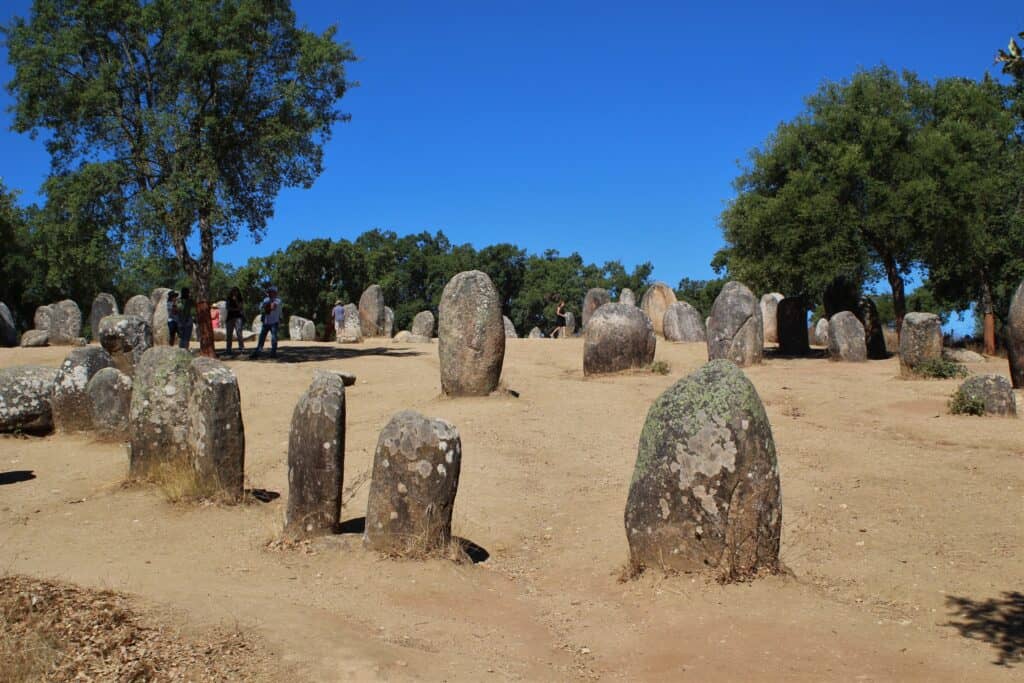
The Almendres Cromlech is a collection of 95 granite monoliths. The stones range in size from 10 feet high to smaller stones the size of a chair. Over time, the granite stones have suffered from erosion and the markings on them have faded dramatically.
The stones are arranged in two concentric circles. The smaller circle, archeologists believe, was constructed about 6,000 BCE, during the Early Neolithic period. The second, and much larger, circle was constructed around 5,000 BCE with additional stones placed about 4,000 BCE.
The Almendres Cromlech site is the largest megalith installation on the Iberian Peninsula and one of the largest in Europe. Like all megalith arrangements, its purpose isn’t certain. However, because of the way the stones line up with the sun during the spring equinox, it is believed that perhaps the stones served as some kind of celestial clock or observation point.
Several of the stones have carvings in them. The meaning of these carvings, like that of the rock arrangements themselves, remains unknown.
Less than a 10 minute drive (or a dusty 30 minute hike) from Almendres Cromlech is the Almendres Menhir site. A single (and taller) monolith lies at the end of a short train in the middle of some farmland.
Transportation
There is no commercial airport in Évora, so you will need to arrive by car (90 minute drive from Lisbon), bus (1 hour 45 minutes from Sete Rios station in Lisbon) , or train (90 minutes from Entrecampos station in Lisbon).
You can also get to Évora from Setubal by bus (75 minutes) or by train (transfer at Pinhal Novo).
Once you arrive by bus or train it’s about a 20 minute walk to the historic center of Évora.
Taxis and rideshare with Uber and Bolt are available in Évora.
There is also a local bus service with a few routes, but Évora is very walkable. Be forewarned, the streets are paved with very rough and uneven cobblestones. There are often no sidewalks. Your feet will take a beating so bring good walking shoes and leave the heels at home!
Index of Things to do in Évora
Roman Temple of Évora (Templo romano de Évora)
Roman Temple right is the center of historic Évora.
Largo do Conde de Vila Flor, 7000-863 Évora, Portugal
Cathedral of Évora (Catedral de Évora)
Spectacular Gothic cathedral.
Largo do Marquês de Marialva, 7000-809 Évora, Portugal
St. Francis Church (Igreja de São Francisco)
Impressive Franciscan church.
Praça 1º de Maio, 7000-650 Évora, Portugal
Chapel of Bones (Capela dos Ossos)
Chapel decorated with the bones of local residents of Évora.
Praça 1º de Maio, 7000-650 Évora, Portugal
Chapel of São Brás
Manueline-style 15th century church looks more like a castle. Unpredictable opening hours.
Av. Dr. Francisco Barahona 1, 7005-150 Évora, Portugal
Praça do Giraldo
Main square in Évora with several cafes and restaurants.
Praça do Giraldo, 7000-661, Évora, Portugal
Prata Aqueduct (Aqueduto da Água de Prata)
16th century aqueduct.
R. do Muro 8, 7000-592 Évora, Portugal
Royal Palace of Évora
14th century royal palace.
Paços de Évora / Palácio de Dom Manuel, R. 24 de Julho 1, 7000-650 Évora, Portugal
Jardim Público de Évora
Public garden adjacent to the Royal Palace.
R. da República 74, Évora, Portugal
Casas Pintadas (Centro de Arte e Cultura)
Arts and Culture center was once the Court of the Portuguese Inquisision. Tours by appointment.
Largo do Conde de Vila Flor, 7000-804 Évora, Portugal
Igreja de Graça
Church now used by the military. Not open to the public, but the façade is magnificent.
R. da Graça 15, 7000-919 Évora, Portugal

Roman House Ruins – Domus Burgos
Roman baths.
Alcárcova de Cima 2, 7000-508 Évora, Portugal
Palace of the Dukes of Cadaval (Paço dos Duques de Cadaval/Palácio dos Duques de Cadaval)
Palace near the Roman Temple. As of this writing the palace is closed for renovations.
Museum Frei Manuel do Cenáculo
Collection of items from Roman times to 18th century including a multi panel painting formerly housed the the cathedral.
Largo do Conde de Vila Flor, 7000-804 Évora, Portugal
Palace of the Counts of Basto (Palácio dos Condes de Basto / Paço de São Miguel da Freiria / Palácio do Pátio de São Miguel)
Palace near the Roman Temple. As of this writing, closed for renovations.
Páteo de São Miguel, 7000-812 Évora, Portugal
Holy Spirit College of the Order of Christ (Colégio do Espírito Santo/Colégio da Companhia de Jesus/Universidade de Évora)
Second oldest university in Portugal.
R. do Cardeal Rei 6, 7000-645 Évora, Portugal
Fountain of Portas de Moura (Chafariz das Portas de Moura/Fonte da Porta de Moura)
16th century marble fountain.
Largo da Porta de Moura, 7000-647 Évora, Portugal
Almendres Cromlech
“Portugal’s Stonehenge” is a site of ancient megaliths 30 minutes from Évora.
Index of Places to Eat & Drink in Évora
Pastelaria Conventual Pão de Rala
Incredible bakery with a wide selection of Évora pastry. Highly recommended.
R. de Cicioso 47, 7000-658 Évora, Portugal
Pastelaria Violeta
Bakery with excellent Queijadas de Requeijao de Évora.
R. José Elias Garcia 47, 7000-582 Évora, Portugal
Botequim da Mouraria
Top notch classic Portuguese dishes. Lunch only. Highly recommended.
R. da Mouraria 16A, 7000-585 Évora, Portugal
Origens
Michelin recognized restaurant with several veg. options.
R. de Burgos 10, 7000-863 Évora, Portugal
Momentos
Michelin recognized restaurant.
R. Cinco de Outubro 61, 7000-854 Évora, Portugal
Salsa Verde
Nice vegetarian buffet.
R. do Raimundo 93 A, 7000-661 Évora, Portugal
A Bruxa D’Évora
A few veg. selections on the menu.
R. Cinco de Outubro 86, 7000-854 Évora, Portugal
Padaria Amarelo
Bakery where you can get Pão Alentejano.
R. de Aviz 150, 7000-574 Évora, Portugal
Café Alentejo
Classic Portuguese fare.
R. do Raimundo 5, 7000-661 Évora, Portugal
Enoteca Restaurante Cartuxa
Wine bar and restaurant from the famous winery Cartuxa. Highly recommended.
R. de Vasco da Gama nº15, 7001-901 Évora, Portugal
Index of Shopping in Évora
Enoteca Restaurante Cartuxa
Wine bar and restaurant from the famous winery Cartuxa. Also sells Cartuxa wine by the bottle.
R. de Vasco da Gama nº15, 7001-901 Évora, Portugal
Adega Ervideira
Wine shop selling bottles from the excellent Alentejo winery Ervideira.
R. Cinco de Outubro 56, 7000-854 Évora, Portugal
Zé do Bacalhau
Deli with a nice selection of regional food products including Alentejo cheese.
Praça 1º de Maio 29, 7000-671 Évora, Portugal
Mercado Municipal 1º de Maio
Small indoor market near the Bone Chapel.
R. Eça de Queiroz, 2830-344 Barreiro, Portugal
Index of Places to Stay in Évora
PatinhaINN
Inexpensive inn with nice, comfortable rooms.
R. dos Mercadores 85A, 7000-530 Évora, Portugal
Pousada Convento Évora
Stay in a15th century church.
About the Author

Brent Petersen is the Editor-in-Chief of Destination Eat Drink. He currently resides in Setubal, Portugal. Brent has written the novel “Truffle Hunt” (Eckhartz Press) and the short story collection “That Bird.” He’s also written dozens of foodie travel guides to cities around the world on Destination Eat Drink, including in-depth eating and drinking guides to Lisbon, Porto, Sintra, Monsaraz, and Batalha . Brent’s podcast, also called Destination Eat Drink, is available on all major podcasting platforms and is distributed by the Radio Misfits Podcast Network.

